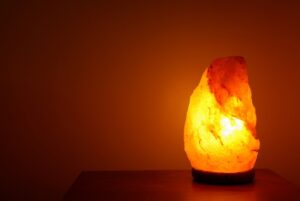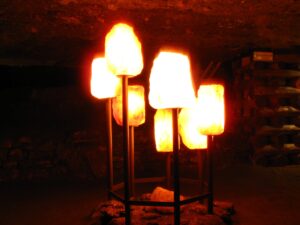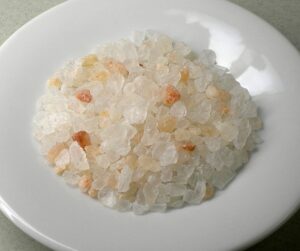Himalayan Salt Lamps: Hype or Help?
 We received a “Himalayan salt lamp” for Christmas this year from well-meaning relatives. The manufacturers of these lamps claim that the heated salt crystal releases negative ions into the environment, countering positive ions and electromagnetic waves. These manufacturers (and sellers of the lamps) have posted all sorts of “science” pages explaining how the lamps work and why. The only problem: These pages contain no actual science whatsoever, and no links to any scientific studies proving effectiveness, yet the explanations claim to “prove” through science that they work. So what’s the deal? They’re pretty, no doubt about that, but do they do what they say?
We received a “Himalayan salt lamp” for Christmas this year from well-meaning relatives. The manufacturers of these lamps claim that the heated salt crystal releases negative ions into the environment, countering positive ions and electromagnetic waves. These manufacturers (and sellers of the lamps) have posted all sorts of “science” pages explaining how the lamps work and why. The only problem: These pages contain no actual science whatsoever, and no links to any scientific studies proving effectiveness, yet the explanations claim to “prove” through science that they work. So what’s the deal? They’re pretty, no doubt about that, but do they do what they say?
 The simple truth is no, they don’t. Scientific analysis of these lamps using proper measurement tools to measure the amounts of negative ions released found that there were a TINY number of negative ions released, but any smaller amount would have been unmeasurable, it was so low. Do these negative ions have any impact on the surrounding environment? Well, since the ions do not move far beyond the immediate vicinity of the lamp, no. Another claim I read was that the lamps absorb moisture from the air, forcing any airborne particulates attached to the water molecule to come out of the air, too, and then “sweat” the moisture back out into the air. If this was true, then any warm, absorptive material would have a similar effect. A warm block of unfinished wood, for instance, should do the same. The “benefits” of salt lamps that some people experience can be likened to a placebo effect.
The simple truth is no, they don’t. Scientific analysis of these lamps using proper measurement tools to measure the amounts of negative ions released found that there were a TINY number of negative ions released, but any smaller amount would have been unmeasurable, it was so low. Do these negative ions have any impact on the surrounding environment? Well, since the ions do not move far beyond the immediate vicinity of the lamp, no. Another claim I read was that the lamps absorb moisture from the air, forcing any airborne particulates attached to the water molecule to come out of the air, too, and then “sweat” the moisture back out into the air. If this was true, then any warm, absorptive material would have a similar effect. A warm block of unfinished wood, for instance, should do the same. The “benefits” of salt lamps that some people experience can be likened to a placebo effect.
- http://www.negativeionsinformation.org/saltcrystallamps.html
- http://www.snopes.com/salt-lamps-cure-everything/
- http://www.drweil.com/health-wellness/balanced-living/healthy-home/are-himalayan-salt-lamps-worthwhile/
 Is Himalayan salt actually from the Himalayas? Again, no. It is from an area NEAR the Himalayas, but salt comes from oceans, and the Himalayas are mountains, and 190 km away from the source of the salt. The actual mine is in the foothills. Yes, I realize Wikipedia’s a lousy reference, but all the sources of information seem to agree with Wikipedia on the location of the salt’s origin. Is the salt more pure because it’s been encased in rock and coated in snow? Well, if you believe the scientific analysis of the salt, and the claims that it contains traces of 84 different minerals, then you know it’s not pure. Most of the elements found in Himalayan pink salt are harmless, found in minute quantities, and already found in sufficient quantity in the average diet (thus adding them to your diet by eating the salt isn’t necessary). The included contaminants do, however, include toxic and radioactive elements. Sea salt is decried as containing more contaminants due to pollution, but it’s processed to remove as much as possible, and sometimes collected through methods that allow the water to become more purified before salt extraction, such as protected lagoons. Himalayan pink salt is less processed (though still mined with large, dirty machinery), so those dangerous things are left in. It’s your call on whether you feel that makes it better.
Is Himalayan salt actually from the Himalayas? Again, no. It is from an area NEAR the Himalayas, but salt comes from oceans, and the Himalayas are mountains, and 190 km away from the source of the salt. The actual mine is in the foothills. Yes, I realize Wikipedia’s a lousy reference, but all the sources of information seem to agree with Wikipedia on the location of the salt’s origin. Is the salt more pure because it’s been encased in rock and coated in snow? Well, if you believe the scientific analysis of the salt, and the claims that it contains traces of 84 different minerals, then you know it’s not pure. Most of the elements found in Himalayan pink salt are harmless, found in minute quantities, and already found in sufficient quantity in the average diet (thus adding them to your diet by eating the salt isn’t necessary). The included contaminants do, however, include toxic and radioactive elements. Sea salt is decried as containing more contaminants due to pollution, but it’s processed to remove as much as possible, and sometimes collected through methods that allow the water to become more purified before salt extraction, such as protected lagoons. Himalayan pink salt is less processed (though still mined with large, dirty machinery), so those dangerous things are left in. It’s your call on whether you feel that makes it better.
 Are they safe? Some of these salt lamps (sold at Michael’s) were recently recalled due to overheating dimmer switches. Those ones probably aren’t so safe. In general, there’s no reason having a block of warm salt in your house should cause you or your family any harm, unless you or your pets lick or eat it. Rock salt such as is found in salt lamps contains a number of minerals which can be unhealthy for human consumption, or consumption by certain animals. As long as it’s not recalled and it’s not being eaten, there’s no reason not to have one of these lamps in your home, other than the power consumption of the incandescent light fixture within.
Are they safe? Some of these salt lamps (sold at Michael’s) were recently recalled due to overheating dimmer switches. Those ones probably aren’t so safe. In general, there’s no reason having a block of warm salt in your house should cause you or your family any harm, unless you or your pets lick or eat it. Rock salt such as is found in salt lamps contains a number of minerals which can be unhealthy for human consumption, or consumption by certain animals. As long as it’s not recalled and it’s not being eaten, there’s no reason not to have one of these lamps in your home, other than the power consumption of the incandescent light fixture within.
Will we keep the lamp? Sure! It’s not one of the recalled lamps. Do I expect it to solve all (or any of) my medical issues? Nope. Has it so far? Nope. If I expected it to, would it? No more than a placebo cream or pill. It’s pretty, and gives off a nice glow. That’s about it. Nevertheless, I like it. Would I spend my own money to buy another? Probably not.
